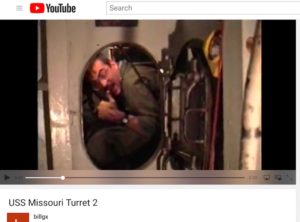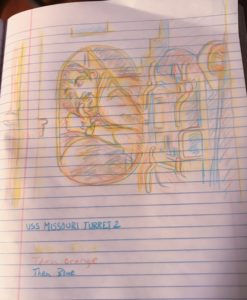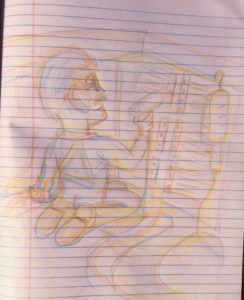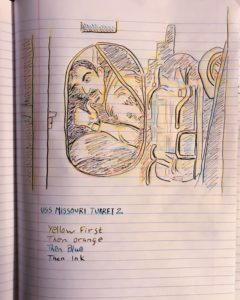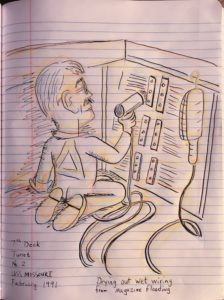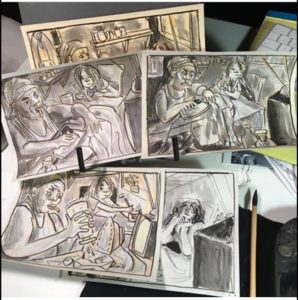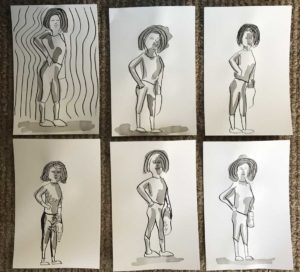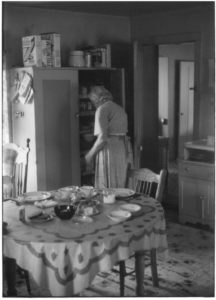PacEx 89 was something to see. I was there.
Monthly Archives: January 2020
Three Color Sketching Technique
January 17th marked the 29th anniversary of the first day of Operation Desert Storm. I know, I know, it was January 16th in the US, but in the gulf, it was already the morning of the 17th. To celebrate, I made a couple of drawings of an incident that happened on my ship while I was there. After the cease-fire, the ammunition magazine of turret number 2 was flooded. I had to lead a team into the bowels of the ship, all the way down to Deck 7, to dry out some of our fire control system wiring that had been soaked with sea water. Interestingly, the insulation on our wiring was from the 1940s, a time in which plastic had not been invented yet, so each wire was wrapped in cotton fabric braided material. Needless to say, the salt water caused a bunch of short circuits. My team had to blow dry each wire and check it for shorts. It took us many hours to get everything dried out and the hardest part was the fact that we were crouched down in a dark, damp crawl space, not really made for human habitation. It was only about four feet high, if I remember right, not even big enough for a child to stand upright in.
The first drawing is taken from a YouTube video that I posted of us going in and out of the crawl space. The second is simply from memory of what it was like to be in that space.
I made 3 color sketches, starting with yellow, then re-drawing with orange, and finally redrawing the same picture with blue. The final step is to ink it in.
This is a new technique for me to try that I learned about via Lynda Barry’s Instagram.
I think I spent about four hours doing these two drawings. If I follow Lynda B’s example, I am still ten drawings and 20 hours away from making a dozen pictures of the same scene. With school starting next week, it might take me a couple of weeks to get that done. We’ll see…
Drawing is Always a Struggle – An Interview with Art Spiegelman
I am reading an interview with Cartoonist Art Spiegelman. Right away he gets to the essence of comic art:
In my line of work, one is always hunting for that essentialization. Comics do that especially well. They permit you to boil down an image and a thought to its essence, with the two circuits mixing the words and images.
He talks about Emil Ferris’s My Favorite Thing Is Monsters.
What I admired about her was that she had taken so long to gestate her first book—she was nearly fifty, I think—and that she had to relearn how to draw after West Nile virus left her unable to hold a pencil.
Wow, a first book at fifty? I will need to look into this book and it’s author. And put Spiegleman’s Maus book on my wish list.
Lines of Code That Changed Everything
How often do we think about how computer programs impact our lives? It is actually a form of media literacy to consider the biases of software engineers who write the code that we use. What do they include and exclude? Personally, I think if you’ve never written a line of computer code, you can never fully understand this digital world in which we all now exist.
This article was shared with me by colleague Dr. Ruth Mirtz. Lines of Code That Changed Everything.
It is a descriptive list of the top computer programs of all time. From the first video game to the first e-mail program. Dive into the article to better understand computer history and the world we are now living in.
Firing the Battleship Guns
I recorded this footage in 1991 aboard the USS Missouri. My job was to communicate between the bridge and the plotting room to ensure we knew the exact location of the ship. You can only hit the intended target if you know exactly where you are firing from. This seems trivial today when GPS is used by everyone, but GPS was pretty new technology back then. We used radars and other navigational techniques along with GPS to verify we knew our position.
Barry on Three Color Drawing
My oh my, Lynda Barry has been sharing a flurry of work lately. In this post, she talks about drawing the same picture three times in yellow, then orange, then blue. I have never heard of this technique before. She learned it from another cartoonist. I’m going to have to learn more about Art Spiegelman now.
Merging Canvas Course Sections
Thanks to Lisa Shappee, our resident Canvas expert, I now know how to merge two course sections into one course. It is not an easily discoverable process, but the directions are recorded in this K-State how-to post.
Value of a Series
I have been learning so much from cartoonist and accidental professor Lynda Barry. Her recent books have been profoundly informative about her creative process. I went to her Wisconsin workshop last November. As I anxiously awaited for that big day to arrive, I acquired several more of her books as companions to Syllabus, the book that introduced me to her work. The one that spoke deeply to me was 100 Demons, in which she discussed various formative events in her life along with a quick primer at the end on the art of using a Chinese paint brush with an ink stone and grinding ink. One of these brushes appears in the picture shown above.
I absolutely love it when Lynda shares her process and her working environment with us, and she does this frequently on social media. For me, it gives me hope. Not hope that I can be just like her if I only master her processes and techniques because there is only one Lynda Barry. But hope that I can be a better version of myself. Hope that there is something inside of me waiting to get out if I will only get busy working.
The thing that I notice in my students and if I’m honest, in myself as well is the tendency to want to short-circuit things. We want a simple fix. We want instant expertise, but it doesn’t work this way. In recent days, Lynda has been sharing one simple truth with us.
Insight takes time to acquire. Don’t try to rush it.
The thing that I always want to pass along to students, and keep in the forefront of my own mind is that nothing worth achieving comes easily or on the first try. So often we bang something out in response to an assignment or an idea and call it good. We think we are done after one iteration! True greatness doesn’t work that way.
Look at how many different times Lynda Barry has drawn the exact same scene. She is trying to gain understanding by staying in motion. She writes:
Something starts to happen when I draw the same scene a dozen times from memory. The drawings don’t get better or worse as I go. Instead the scene seems to come in and out of focus. I have to really push past wanting to stop. (Emphasis mine) when I can’t tell where it’s going to get to this other thing I can’t see while it’s happening.
I decided to experiment with this process, making several versions of the same image as well.
Her comment this morning about having to push past wanting to stop is what anyone who is at the pinnacle of their game has to do every single day. You don’t win the state championship, the gold medal or anything of importance by quitting after the first rep. You have to keep going.
I thought I was doing something special when I made six! I quit when I was only halfway finished. Also, one thing I have noticed about some of these recent drawings as compared to the drawings I was making at Lynda’s workshop when I look back at them is that I was drawing backgrounds with most every image and now I seem to have nothing to say about the background scenery.
Just look at the exquisite detail in the pictures L.B. has posted above. Obviously she has been doing this a long time, and probably can make detailed images like these much faster than regular people, but even so, a dozen images like what she’s showing us took her some time to make. I suspect it would take me an hour to make one picture that even approaches what she’s showing here. Next time, I will block out more time and try to make 12 iterations, remembering to include background details.
Thank you Lynda Barry, for showing us what greatness looks like.
William Gedney – Grandma
Sketches of a young woman
I was looking for something to draw yesterday morning and I found a sketch in my sketchbook that I liked. I made several iterations of that same sketch. It is so strange how differetnly these all turned out. I am not sure, but I think this might be the same woman that is in Anna and her daughter.
